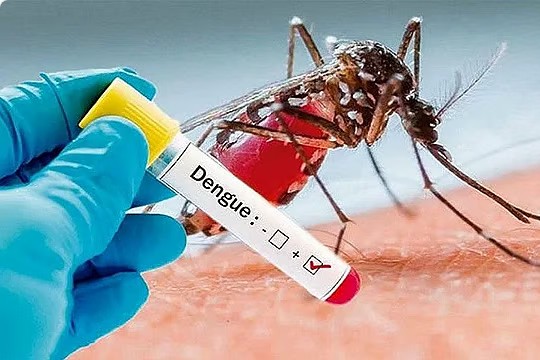Hospitalized 65 patient
As many as 326 people were hospitalised with dengue across the country on Wednesday, the Directorate General of Health Services (DGHS) said.
Of them, 65 patients, around 20 per cent of the infected, were from Barguna. This southern district of the country has now become a major hotspot for dengue.
The high transmission rate in Barguna has been continuing for several weeks, raising concerns and prompting discussions.
In this context, the Institute of Epidemiology, Disease Control and Research (IEDCR) conducted a survey on aedes mosquito larvae in Barguna earlier this month. The results of the survey were revealed at a press conference on Wednesday.
According to the survey findings, larvae of aedes mosquito, the carrier of the dengue fever virus, were found in 31 per cent of homes in Barguna pourashava and in 76 per cent of rural households.
It was said in the press conference that the residents in Barguna generally collect and store rainwater due to a shortage of safe drinking water. Since aedes mosquitoes breed in clean and stagnant water, these water containers have become their ideal breeding grounds. In rural areas, water is often stored in plastic drums covered with cloth. A huge amount of larvae were found in those clothes as well.
IEDCR’s Medical Social Science Division chief scientific officer Ratna Das insisted at the press conference that water should not be stored for more than two days.
She pointed out that due to water scarcity in Barguna, people often store water in the drums without disposing of the previously stored water.
Moreover, those water containers are usually left uncovered, making them conducive to mosquito breeding. This has significantly contributed to the serious outbreak of dengue in the area.
The survey team collected data from 184 households in Barguna, including 138 from the pourashava area and 46 from other areas of the Sadar upazila. Larvae were found in 43 urban homes (31 per cent) and 35 rural ones (76 per cent).
Use of “Breteau Index (BI)” is a recognised method for measuring the density of aedes mosquito larvae. A BI of 20 or higher indicates a high prevalence of larvae. In Barguna pourashava, Wards 7 and 9 reported extremely high BIs, 153 and 133 respectively. The BI in the rural area was even higher, 163.
Speaking about the findings, IEDCR adviser Mushtuq Husain told Prothom Alo on Wednesday that the spread of aedes mosquitoes in the rural areas of Barguna is very alarming.
He, however, cautioned that this may not be unique to Barguna. Similar findings could emerge if surveys were conducted in other parts of the country, Mushtuq Husain remarked.
Addressing the conference, IEDCR director Tahmina Shirin emphasised that the rising number of dengue cases is making it increasingly difficult to ensure enough hospital beds, physicians, and nurses.
She stressed the need to control dengue at its source. She also noted that no chikungunya or Zika viruses were detected in their research.
According to the survey, homes with only one family showed higher larval presence. Out of 48 such houses, 24 had larvae.
There are four serotypes of dengue fever: 1, 2, 3, and 4. In previous years, serotype-2 was the most common in Bangladesh. However, by the end of last year, some presence of serotype-3 was detected.
IEDCR’s dengue outbreak survey team chief Tarikul Islam said, “Serotype-2 was dominant in Dhaka until last year. We don’t yet have this year’s data from the capital city, but in Barguna, we have found serotype-3 to be more prevalent in the 43 samples we tested.”
Stating that greater transmission and more severe cases could be results of the dominance of a new serotype, Mushtuq Husain urged the DGHS to take more proactive measures to control the situation.
This is not the first time Barguna has seen a major dengue outbreak. Excluding Dhaka city, Barguna had the fifth highest number of dengue cases in the country last year. Nearly 2,500 people were infected from dengue virus that year.
Report Courtesy: prothomalo.com





